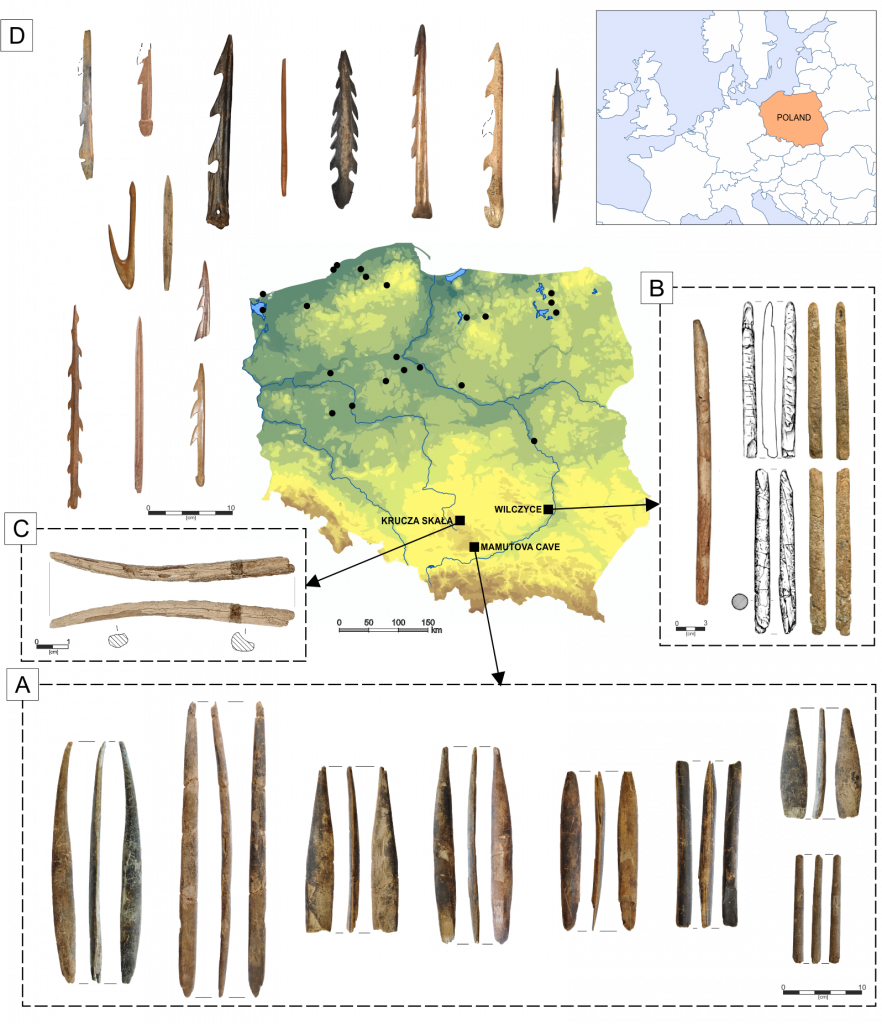The research is of multi-phase nature and includes, among others, experimental works, macroscopic and microscopic analysis, radiocarbon dating, and micro CT analysis. The overall research plan provides the study of projectiles made from osseous raw materials from Polish sites associated with Late Palaeolithic and Mesolithic communities. Projects include archival artefacts from excavated sites with established chronology and stray finds.
a) Site Mamutowa Cave (PL: Jaskinia Mamutowa) – located on the left slope of Kluczwoda valley; about 20 meters above its floor. The first excavations on the site were conducted by J. Zawicza at the end of the XIX century. Most of the bone artefacts are associated with the Aurignacian and Gravettian cultures. Bone artefacts in a kind of projectile weapons are represented by more than twenty Mladeč-type points (40,000–35,000 cal BP), two baguettes demi-ronde and three cylindrical artefacts (Fig.1A). Osseous materials from this site were studied only from the zooarchaeological and taphonomical perspectives (Wojtal 2007).
b) Site shelter of Krucza Skała (PL: schronisko Krucz Skała) – situated on the northern slope of the Łysak hill, within the Kroczyce Rocks, in the central part of Kraków-Częstochowa Upland. Archaeological excavations at the site were carried out in 1989-1993 by Krzysztof Cyrek from the Museum of Archaeology and Ethnography in Łódź (Cyrek 1994a, b). A unique ornamented artefact was found in the oldest cultural layer of the shelter and is probably a part of the so-called baguette demi-ronde (Fig. 1C). The artefact was directly AMS dated to a middle part of the Allerød oscillation (11,920±70 uncal BP, Poz-2974) and has analogies in the Franco-Cantabrian mobile Palaeolithic art (Cyrek 1994b).
c) Site Wilczyce (PL: Wilczyce, stan. 10) – located in southern Poland, on the Sandomierz plateau overlooking the Opatowka river valley. Systematic works were carried out here since 1998, first by Jan Fiedorczuk and after his death by Romuald Schild. Site placement, the character of deposition, and the types of remains suggest a seasonal hunting camp (Bratlund, 2002; Fiedorczuk and Schild, 2002). From the site, the second numerous in Poland collection of bone tools associated with Magdalenian comes (Fig. 1B). Traces of bone-working were observed on 147 artefacts; 59 of these were qualified as tools (among others 13 points and baguette demi-ronde; Boroń 2009; 2014). According to the 14C results the Wilczyce site fits within the upper horizon of the Magdalenian (about 15,300 cal BP; Fiedorczuk et al., 2007), which seems to confirm the theory that Magdalenian sites in central and eastern Europe belong for the most part to the upper and terminal phases of this culture.
The important part of the conducted research will represent objects discovered by accident, in most cases outside their original archaeological context, that is, the so-called „stray finds” from the Late Palaeolithic and Mesolithic. In total, around thirty specimens of this type will be subjected (Fig.1D).

